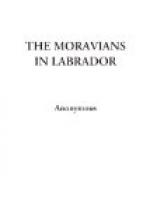During the following year, [1776,] the brethren were busily employed in cutting down wood in the forest near Nain, and preparing it for a dwelling-house at the new station; and so diligent were they in their work, that in August, when the ship Good Intent arrived from England with the other necessary articles for building the house, the timber was all ready to be shipped for Okkak. On the 13th September, Jans Haven, with his family and three other missionaries who had been appointed for the new settlement, arrived there, and immediately went to work and erected their house. “I had,” says the devoted Haven, “the peace in all trying circumstances to cleave to my Saviour, of whose gracious assistance I had manifold experience. He was with us, and gave us success in our present enterprise. Having finished the building of our house, we moved into it; and in our first conference, were so united by the power of Jesus’ grace in brotherly love and harmony, that we made a covenant with each other to offer soul and body to the Lord, to serve him without fear, and bear each others’ burdens with a cheerful heart. Nor did we meet with the least interruption during the whole year, so that I justly count it the happiest of my life.”
This station lies thirty German miles north from Nain, in 58 deg. 20 m. N.L., and is of great consequence both to the European settlers and the Esquimaux, of whom above three hundred always live near it. There is a good harbour for ships and boats—a supply of wood and of fresh water in summer and winter—great quantities of fish, particularly haddocks—also some whales, but few seals, so that the Esquimaux are obliged to go to various places at a considerable distance for this valuable animal, whose skins are among their absolute necessaries for their tents and clothing. The mission-house is built at the side of a high mountain, which serves as a protection from the north-west wind.
The natives received the brethren with great joy, and evinced a pleasing desire to hear the gospel; but it was not till the 29th of August 1778, that any baptism took place. On this occasion, however, six adults were received into the church by this holy ordinance, and several others soon followed. The baptized lived for the greater part of the winter in the mission-house, where daily meetings were held, and where they received farther instruction, for which purpose a larger meeting-hall was built in 1779.
At length at Nain, also, the brethren had the pleasure in the winter of 1779-80, to see five Esquimaux families, consisting of thirty-seven souls, come to the resolution of remaining during that season in their neighbourhood, and the year after their number increased from seventy to eighty; by this means the brethren were enabled to collect small congregations at each station, and in the winter at least carefully to observe their conduct, and to give them regular employment. Meanwhile the mission work proceeded; they held daily




